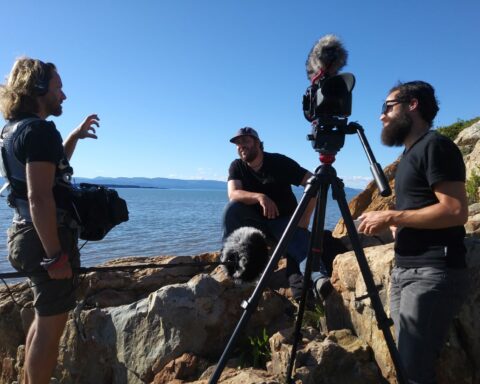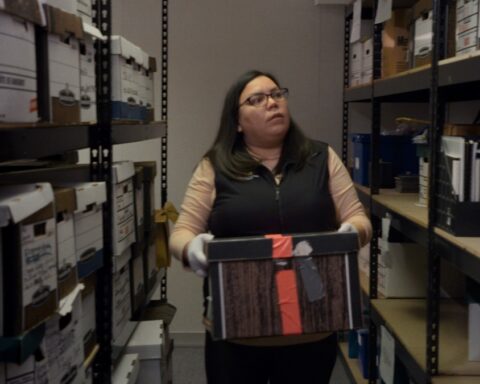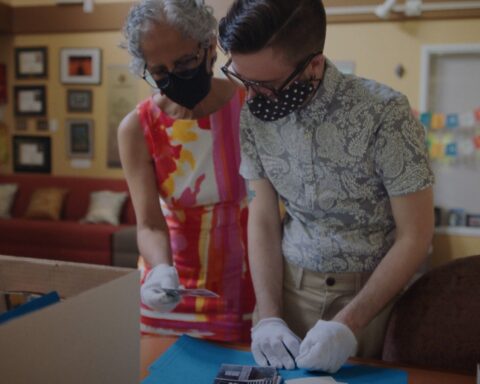ZERO THE INSIDE STORY, the latest film from Elida Schogt, deals with personal pain, the meaning of life, self-image and, not incidentally, the history of the number zero. Schogt, sitting comfortably on a patio the day after the Toronto International Film Festival has concluded, with two sold out showings of her film, is clearly pleased at the reception for her longest, and bravest, work. “You always take a chance when you make a film, regardless of what the subject matter is,” she observes. “I think if you ground things in the personal, they become more relevant for other people, as well.”
Schogt’s first three shorts, Zyklon Portrait (1999), The Walnut Tree (2000) and Silent Song (2001) also “bridged the personal and the universal.” They formed a loose trilogy on the Holocaust as it impacted on her life and on that of her family, as well as on the Jewish community. Using experimental techniques, such as hand painted images, voiceovers and, particularly, photographs, the films, respectively, looked at the gas used by the Nazis to murder Jews, a tree outside her mother’s bedroom in Amsterdam and a photograph of a young boy playing an accordion, after being liberated by the Allies.
ZERO the inside story is longer then the trilogy— at 51 minutes it’s nearly twice as long as all three short films combined—and more ambitious. “I think in many ways this film is like Zyklon Portrait. It’s still very psychological; it’s just because it plays out over an hour that the analytical, psychological element has more time to be developed. But Zyklon Portrait also has very clinical explanations and there is a similar use of a shift in voice,” she points out. “In this case, it’s a character/narrator who’s distanced from herself and so it can be read as a psychological space.”
Like her short films, ZERO also includes Schogt’s trademark use of extensive narration, which she strongly believes is necessary for her films. The narration links the film’s twin searches, for the meaning of the number zero and for the narrator’s understanding of her inner self. ZERO the inside story examines the number—the way it is and can be perceived and its history—and contrasts that with the female narrator’s attempts to find herself through learning about the number, thereby combating her low self image, which makes her feel like a zero. Yet, despite its strongly overlaid narrative, ZERO does not sacrifice or diminish Schogt’s symbolic visual motifs. “The narrative of the search for the origin of the number zero and the woman’s search inside herself play out in a more linear way than the earlier works but I felt the metaphoric approach is as strong or even stronger (than in earlier work),” declares Schogt.
In that psychological vein, the character/narrator in ZERO the inside story is also the possessor of a startling secret, revealed late in the movie, centering on the abuse that the thirtysomething Schogt experienced many years ago. It’s surprising because until then the viewer is under the impression that the narrator is not Schogt but a nameless, unknown woman who suffers from low self-esteem.
Despite bravely putting it in her film, Schogt is demonstrably uncomfortable discussing the film’s revelation. “I think of the film as inspired by a personal experience, inspired by something that happened to me in my childhood but I’m more interested in how that story fits in the larger themes. The film explores the idea of the difficulty of talking about that kind of personal trauma; it’s embedded in the narrative, this idea of whether you should speak or not speak about things that are secret or this deeply personal.”
With its trips to Mexico, where Schogt investigated the extinct Mayan culture where zero played a large part, and to India, reputedly the birthplace of the number, ZERO also plays out on a larger canvas than anything Schogt has yet done. The film, she agrees, is “by far the most challenging, technically and creatively” she has attempted. Thematically, she describes her latest work as using mathematics as a jumping off point. “Mathematics is the most concrete starting point. The film evolves that way, too. It starts out with the kind of Western linear schoolbook approach of asking the expert to explain things but along the journey it becomes clear that the character is not finding out what she’s looking for, so she goes from mathematics to philosophy. And when she still can’t find what she’s looking for, then she delves deeper and looks into the spiritual. So it’s not really a film about mathematics at all. By the end of the film you have the sense of an individual being part of a collective and thus, like zero, having gone from being an isolated symbolic entity to something within the number system, within our consciousness.”
Schogt’s unique way of looking at things is, in many ways, a product of her time spent studying at New York’s New School for Social Research, a prestigious institution that also challenges contemporary notions of how films should be made. There, Schogt fell under the influence of two acclaimed American filmmakers, Su Friedrich (Rules of the Game; Hide and Seek) and Alan Berliner (Intimate Stranger; Nobody’s Business.) “They inspired me to combine documentaries with personal work, a diary approach, and also to use experimental techniques.”
Schogt doesn’t cite too many other influences, except Chris Marker (Sans Soleil; La Jetée) and Chantal Akerman, whose From the Other Side, a video work filmed and recorded along the Mexican – American border, affected the look of ZERO the inside story. “She influenced me in terms of long takes. She had such a sustained and deliberate use of panning in that film. That really inspired me; the film had that horizontal plane.”
Schogt’s personal background has, quite naturally, affected her work. Her Dutch mother is Jewish and was hidden as a child during the War while her Dutch father was a gentile whose family hid Jews then. She wasn’t raised Jewish and never fit into Jewish circles or Dutch ones, either. “Neither religion nor cultural groups were part of my upbringing. I see myself as more of a hybrid than someone belonging to any distinct group. And, I like to think of work that way, too.”
Unlike her shorts, which were low budget productions generally funded by the Ontario Arts Council and the Toronto Arts Council and their like —Zyklon Portrait only cost $25,000 and “the last short (Silent Spring) cost a few thousand dollars”— Schogt had a lot more money to play with for ZERO. “The budget was astronomically more expensive than the shorts.” Besides funding from the Arts Councils, she gained the support of many key players, including the Rogers Industry Fund, The Canadian Independent Film & Video Fund, the Canadian Television Fund, The National Film Board of Canada —Filmmaker Assistance Program and, notably, TV Ontario.
That backing allowed her to roam far and wide logistically with her film but, more significantly, gave her the moral and financial support she needed at this time and for this project. “I was ready to do something where I could take people somewhere and have them experience the film for a longer duration.” Though she considered at one point making it a feature length (70 minute) movie, the final result is exactly the length she wanted it to be and not a television imposed running time. TVO has scheduled a broadcast of ZERO for January 2005, potentially bringing Schogt a much greater audience for her film than would have seen all her previous shorts.
ZERO did allow Schogt to make a living off her work, for a change. “I sustained myself through this project because I worked as both producer and director. I got to pay myself but had to make sure I raised the funds to pay myself.” Like most nontraditional filmmakers, it’s still a hard slog for Schogt to get projects off the ground. “It’s a challenge to create work that’s not genre specific and also to try to make larger scale projects when you’re working against the mainstream. Funding is more difficult to come by.” So far, at least, Elida Schogt is managing to work against the mainstream just fine.











